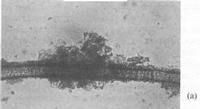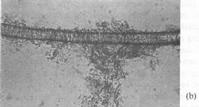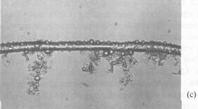


Chapter 5
I 1788 - State Of The Art In Textile Technology
II Australian Textiles - The Early Days
III Australian Textiles - The 20th Century
i Technology and Development
ii Australian Wool Textile Research
IV Australian Textiles - To Date
V Acknowledgements
References
Index
Search
Help
Contact us

Australian Wool Textile Research (continued)
Various traditional approaches to on-site water treatment were tried, e.g. the University of N.S.W. investigated acid cracking,[31] but few found significant industrial acceptance. One promising idea -the UNISAS process[32] -has not yet (1986) been adopted in scouring, but has been taken up in the food industry. This is an activated sludge process, but incorporates a mechanical concentrator, such as a decanter centrifuge, instead of a gravity clarifier as used in the conventional process. This enables the process to work with a high biomass concentration in the aerator reactor, which allows its volume to be kept small.As well as investigating less conventional treatment, e.g. ultra-filtration, CSIRO, Geelong, investigated the utilisation of the wool contaminants themselves to facilitate contaminant removal. The principle underlying this was to cause the concentration of the dissolved salts (sheep-perspiration and other salts) in the liquor to increase to a level at which the solid suspended solids more readily aggregated and therefore were more readily separated by centrifuging. This was achieved in practice[33] by reducing the volume of water in the first section of the scour and by recycling the liquor repeatedly, recovering grease and dirt (as a spadeable sludge) from the liquor by a series of centrifuges. At equilibrium, theoretically, the water taken out with the dirt and grease and that on the clean wool would balance the water continually fed to this stage. In practice, however, in two full-scale industrial plants, it was found that equilibrium could not readily be achieved, and that the recovery of dirt was below the efficiency expected.
Investigating the causes of these anomalies, the Geelong researchers[34] realized that the presence of protein contaminants (from the sheep's skin and/or from remnants of fibre growth) mixed with the grease on the wool was having very significant effects on the scouring mechanism (Fig. 23). This opened up a completely new approach to wool scouring and effluent treatment,[35] the first practical result of which has been the development of a process[36] for improving the recovery of dirt from waste liquors at much lower cost than conventional treatments. The new knowledge also augers well for the development of new scouring systems that will enable scourers to have better control over the quality of their products while processing at higher rates.[37]




While the scouring of wool has been placed on a more scientific basis over the past four decades, until recently little major development had occurred in the next process, carding. Despite a novel approach[38] by CSIRO that got as far as long-term commercial evaluation, the inventors of the first carding machine -Bourn and Paul (see p.258) -would have easily recognized the basic principles that they are applied. They would, of course, be amazed by the production of the machines and the quality of the product, but this has all been achieved principally by the application of improved engineering techniques through empirical development or by the application of electronics.
Organisations in Australian Science at Work - CSIRO Division of Protein Chemistry; CSIRO Division of Textile Industry
 |
Australian Academy of Technological Sciences and Engineering |  |
© 1988 Print Edition pages 290 - 291, Online Edition 2000
Published by Australian Science and Technology Heritage Centre, using the Web Academic Resource Publisher
http://www.austehc.unimelb.edu.au/tia/293.html